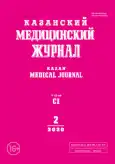Analysis of the effect of immunosuppressive therapy on the progression of chronic kidney disease with mesangioproliferative nephritis
- Authors: Sigitova ON1, Kim TY.1, Sineglazova AV1, Kamasheva GR1, Nadeeva RA1
-
Affiliations:
- Kazan State Medical University
- Issue: Vol 101, No 2 (2020)
- Pages: 175-181
- Section: Theoretical and clinical medicine
- URL: https://journals.rcsi.science/kazanmedj/article/view/19111
- DOI: https://doi.org/10.17816/KMJ2020-175
- ID: 19111
Cite item
Full Text
Abstract
Aim. To assess the effect of immunosuppressive cyclophosphamide therapy and its regimens on the rate of progression of chronic kidney disease in mesangioproliferative glomerulonephritis.
Methods. 72 patients with mesangioproliferative glomerulonephritis and indications for immunosuppressive therapy with disease activation were included in the comparative analysis: 56 patients received cyclophosphan in conventional doses (26 patients with daily or every other day, 30 patients with in pulse mode 1 time per month), and 16 patients did not receive cyclophosphan. Duration of the disease before observation ranged from 0 to 33.58 years, a median follow-up was 6.00 (interquartile range 1.63–13.17) years, and after observation from 0 to 5 years with the median follow-up was 2.00 (1.00–3.50) years. The examination included nephrobiopsia with a morphological diagnosis, activity index/sclerosis, and glomerulonephritis progression rate for decreased glomerular filtration rate (ml/min/1.73 m² per year).
Results. The progression rate of chronic kidney disease was higher in the group of patients not receiving immunosuppressive therapy, 5.57 (3.27–7.95) ml/min/1.73 m2 per year compared with of the treated patients group, 3.05 (2.04–6.78) ml/min/1.73 m2 per year (p=0.040). There were no differences in the rate of decrease in glomerular filtration rate between groups depending on the treatment regimen: 4.86 (2.12–6.77) ml/min/1.73 m2 per year with regular and 3.67 (2.04– 6.91) ml/min/1.73 m2 per year with a pulse mode (p=0.720). The rate of glomerulonephritis also did not differ significantly: 1.0 (1.0–2.0) and 2.0 (1.0–2.0) relapses over 5 years, respectively (p=0.691) in both treatment regimens.
Conclusion. The treatment of patients with mesangioproliferative glomerulonephritis with cyclophosphane, in combination with prednisone or without it, regardless of the treatment regimen induces a slowdown in the progression of chronic kidney disease, improving the long-term prognosis and without affecting the frequency of relapses of the disease.
Full Text
##article.viewOnOriginalSite##About the authors
O N Sigitova
Kazan State Medical University
Author for correspondence.
Email: osigit@rambler.ru
SPIN-code: 3424-7909
Russian Federation, Kazan, Russia
T Yu Kim
Kazan State Medical University
Email: osigit93@gmail.com
ORCID iD: 0000-0003-2370-2972
SPIN-code: 8560-4702
Scopus Author ID: 57208906994
Russian Federation, Kazan, Russia
A V Sineglazova
Kazan State Medical University
Email: osigit93@gmail.com
ORCID iD: 0000-0002-7951-0040
SPIN-code: 4196-1651
Scopus Author ID: 55001894700
Russian Federation, Kazan, Russia
G R Kamasheva
Kazan State Medical University
Email: osigit93@gmail.com
SPIN-code: 1245-3205
Russian Federation, Kazan, Russia
R A Nadeeva
Kazan State Medical University
Email: osigit93@gmail.com
SPIN-code: 4011-8150
Russian Federation, Kazan, Russia
References
- Bikbov B.T., Tomilina N.A. The contingent and treatment quality indicators in patients on replacement therapy of end stage renal disease in the Russian Federation in 1998–2013 years. Nefrologiya i dializ. 2016; 18 (2): 98–164. (In Russ.)
- Jo Y.I., Na H.Y., Moon J.Y. et al. Effect of low-dose valsartan on proteinuria in normotensive immunoglobulin A nephropathy with minimal proteinuria: a randomized trial. Korean J. Intern. Med. 2016; 31 (2): 335–343. doi: 10.3904/kjim.2014.266.
- Kawasaki Y. The pathogenesis and treatment of IgA nephropathy. Fukushima J. Med. Sci. 2008; 54 (2): 43–60. doi: 10.5387/fms.54.43.
- Shilov E.M., Smirnov A.V., Kozlovskaya N.L. Nefrologiya. Klinicheskie rekomendatsii. (Nephrology. Clinical guideline.) Moscow: GEOTAR-Media. 2016; 816 p. (In Russ.)
- Berthoux F.C., Mohey H., Afiani A. Natural history of primary IgA nephropathy. Semin. Nephrol. 2008; 28 (1): 4–9. doi: 10.1016/j.semnephrol.2007.10.001.
- Shilov E.M., Tareeva I.E., Ivanov A.A. et al. The course and prognosis of mesangial proliferative glomerulonephritis. Terapevticheskiy arkhiv. 2002; 74 (6): 11–18. (In Russ.)
- Kidney disease: Improving global outcomes (KDIGO) glomerulonephritis work group. KDIGO clinical practice guideline for glomerulonephritis. Kidney Intern. Suppl. 2012; 2: 139–274. doi: 10.1038/kisup.2012.9.
- Li P.K., Leung C.B., Chow K.M. et al. Hong Kong study using valsartan in IgA nephropathy (HKVIN): a double-blind, randomized, placebo-controlled study. Am. J. Kidney Dis. 2006; 47 (5): 751–760. doi: 10.1053/j.ajkd.2006.01.017.
- Kidney Disease: Improving Global Outcomes (KDIGO) CKD Work Group. KDIGO 2012 clinical practice guideline for the evaluation and management of chronic kidney disease. Kidney Int. Suppl. 2013; 3 (1): 1–150. doi: 10.1038/kisup.2012.73.
- McCarthy D.D., Kujawa J., Wilson C. et al. Mice overexpressing BAFF develop a commensal flora-dependent, IgA-associated nephropathy. J. Clin. Invest. 2011; 121 (10): 3991–4002. doi: 10.1172/JCI45563.
- Eftimovska N., Stojceva-Taneva O., Polenakovic M. Slow progression of chronic kidney disease and what it is associated with. Prilozi. 2008; 29 (1): 153–165. PMID: 18709007.
- Hirahashi J., Hanafusa N., Wada T. et al. Aspirin and eicosapentaenoic acid may arrest progressive IgA nephropathy: a potential alternative to immunosuppression. Intern. Med. 2015; 54 (18): 2377–2382. doi: 10.2169/internalmedicine.54.4623.
- Hirahashi J. Omega-3 polyunsaturated fatty acids for the treatment of IgA nephropathy. J. Clin. Med. 2017; 6 (7): 70. doi: 10.3390/jcm6070070.
- Jalalah S.M. IgG glomerulonephritis: a morphologic study of a rare entity. Saudi J. Kidney Dis. Transpl. 2009; 20 (5): 798–801. PMID: 19736476.
- Chen X., Chen P., Cai G. et al. A randomized control trial of mycophenolate mofeil treatment in severe IgA nephropathy. Zhonghua. Yi. Xue. Za. Zhi. 2002; 82 (12): 796–801. PMID: 12126522.
- Tumlin J.A., Lohavichan V., Hennigar R. Crescentic, proliferative IgA nephropathy: clinical and histological response to methylprednisolone and intravenous cyclophosphamide. Nephrol. Dial. Transplant. 2003; 18 (7): 1321–1329. doi: 10.1093/ndt/gfg081.
- Haas M., Verhave J.C., Liu Z.H. et al. A Multicenter Study of the predictive value of crescents in IgA nephropathy. J. Am. Soc. Nephrol. 2017; 28 (2): 691–701. doi: 10.1681/ASN.2016040433.
- Myllymaki J., Saha H., Mustonen J. et al. IgM nephropathy: clinical picture and long-term prognosis. Am. J. Kidney Dis. 2003; 41 (2): 343–350. DOI: 10.1053/ ajkd.2003.50042.67.
- Sigitova O.N., Kim T.Yu., Salmakova A.V. Flow features of immunoglobulin a nephropathy depending on activity/risk of progression and influence of pathogenetic therapy. BioNanoScience. 2019; 9 (2): 495–501. doi: 10.1007/s12668-019-0594-z.
Supplementary files






